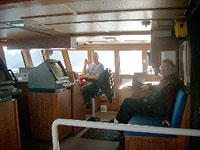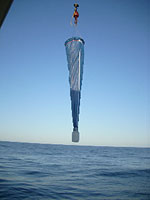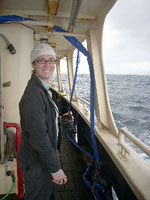

 | |||||||||||||||||||
|
|
Journals 2009/2010Jennifer Duncan
September 18, 2009 Today is our last day out at sea. The sun was rising above the horizon as a yellowish, pink tint and the Gulf of Alaska was finally calm. We worked on five stations today with over 30 filtrations, and many, many nutrient collections later. It is 9:00 p.m. and we are eagerly trying to reach GAK1 before 10:00 p.m. We are all tired from the hard working day. Ryan cooked us yet another fabulous tasty meal. He is gourmet all the way. We had fresh black cod fish with curry sauce, yogurt to mellow the spices, homemade naan bread, and of course a colorful platter of fresh vegetables with all sorts of delicious herbs. The sunset was just as beautiful as the sunrise so it was important we all got the last view. Many of the scientists climbed up to the highest point on the ship to get every last bit of the sunlight. The view was picture perfect with mountains looking like a silhouette. After we took some photos we climbed back down to the bridge to listen to Captain Dan and Hogue play some songs on their guitar. I peeked out of the porthole and I saw three little dall porpoises cruising along with the ship. We were traveling around 8-9 knots and they blew past us with their speeding dorsal fin. They are smaller than our Florida bottlenose dolphin however, they are definitely faster. Ken Kolye, is an assistant professor, past research associate, at UAF since 1971. I had a very informative conversation with him about all his experience here in Alaska. He explained that the Gulf of Alaska waters were actually first explored by the Soviets in the early 1960's. These were the first comprehensive studies for fishers. Temperature and Salinity were tested by the old fashion silver nitrate titrations.He participated in GAK 1 physical parameters studies since 1970. This trip, Ken Koyle, Patrick Pritchett, and John Hogue worked on the night shift pulling the zooplankton net. The diurnal migration of zooplankton was studied by using five multi-nets with a mesh size of 200um or 0.5mL. There are approximately 100 different species of copepods studied at a maximum depth of 100 meters. This takes 40 minutes to complete one tow. Once the net is brought to the surface the zooplankton were preserved in 10% formalin and Rose Bengal stain. Some of the zooplankton absorbed this stain. These samples were stored and brought back to the lab to test for species biomass, composition, and abundance.
The most interesting part about my nighttime research experience was the bioluminescence. This is a marine phenomenon. It is a light that is produced by multiple organisms such as phytoplankton, zooplankton, bacteria, mollusk (such as squid), sponges, jellyfish, echinoderms, and crustaceans (crabs). They give off this light for offense, defense, camouflage, or communication. After we pulled the net up and the boys dragged the heavy net onboard Hogue lightly moved the net and all of these little plankton light up!!! It was a magnificent florescent blue color. Ken explained that the possible types of zooplankton expressing this light here were the euphausids (six species possible), metridia, or the ptenophores. They were extraordinary. Jennifer Questel is a Master's marine biology student, at University of Alaska at Fairbanks, under Dr. Russ Hopcroft. She is studying the somatic production rates for Pseudosalnus, copepods over a three-day period to see if they have produced eggs (clutch). She brings the eggs back to lab to identify them and count the eggs. After this trip she will be traveling to Chukchi Sea, which is north of the Bering Sea. This is one of the marginal seas that make up the Arctic Ocean. She will be studying the zooplankton communities in the shallow shelf at about 40 meters to look at species composition, biomass, and abundance during the ice freeze season. She is sponsored by an oil company.
|
||||||||||||||||||



